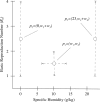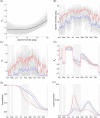Impact of School Cycles and Environmental Forcing on the Timing of Pandemic Influenza Activity in Mexican States, May-December 2009
- PMID: 26291446
- PMCID: PMC4546376
- DOI: 10.1371/journal.pcbi.1004337
Impact of School Cycles and Environmental Forcing on the Timing of Pandemic Influenza Activity in Mexican States, May-December 2009
Abstract
While a relationship between environmental forcing and influenza transmission has been established in inter-pandemic seasons, the drivers of pandemic influenza remain debated. In particular, school effects may predominate in pandemic seasons marked by an atypical concentration of cases among children. For the 2009 A/H1N1 pandemic, Mexico is a particularly interesting case study due to its broad geographic extent encompassing temperate and tropical regions, well-documented regional variation in the occurrence of pandemic outbreaks, and coincidence of several school breaks during the pandemic period. Here we fit a series of transmission models to daily laboratory-confirmed influenza data in 32 Mexican states using MCMC approaches, considering a meta-population framework or the absence of spatial coupling between states. We use these models to explore the effect of environmental, school-related and travel factors on the generation of spatially-heterogeneous pandemic waves. We find that the spatial structure of the pandemic is best understood by the interplay between regional differences in specific humidity (explaining the occurrence of pandemic activity towards the end of the school term in late May-June 2009 in more humid southeastern states), school vacations (preventing influenza transmission during July-August in all states), and regional differences in residual susceptibility (resulting in large outbreaks in early fall 2009 in central and northern Mexico that had yet to experience fully-developed outbreaks). Our results are in line with the concept that very high levels of specific humidity, as present during summer in southeastern Mexico, favor influenza transmission, and that school cycles are a strong determinant of pandemic wave timing.
Conflict of interest statement
JS discloses consulting for JT and Axon Advisors and partial ownership of SK Analytics.
Figures





References
-
- Finkelman BS, Viboud C, Koelle K, Ferrari MJ, Bharti N, Grenfell BT. Global Patterns in Seasonal Activity of Influenza A/H3N2, A/H1N1, and B from 1997 to 2005: Viral Coexistence and Latitudinal Gradients. Myer L, editor. PLoS ONE. Public Library of Science; 2007;2 10.1371/journal.pone.0001296 - DOI - PMC - PubMed
Publication types
MeSH terms
Grants and funding
LinkOut - more resources
Full Text Sources
Other Literature Sources
Medical

